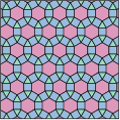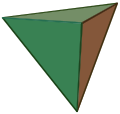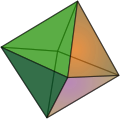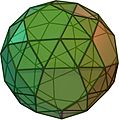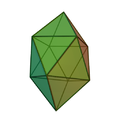Equilateral triangle
An equilateral triangle is a triangle with three sides or edges of equal length and three equal angles of 60 ° each. An equilateral triangle is also known as a regular triangle and is one of the regular polygons . All equilateral triangles are similar to each other . Equilateral triangles are rotationally symmetrical (rotation around the center point by 360 ° / 3 = 120 ° or a multiple thereof), mirror-symmetrical with respect to the three perpendiculars and at an acute angle . Your isometric group is the dihedral group D 3 . With equilateral triangles seamless is tiling a plane possible.
Calculation and construction
An equilateral triangle is completely determined by one side (see congruence theorem ).
| Mathematical formulas for the equilateral triangle | ||
|---|---|---|
| Area | ||
| scope | ||
| Side lengths | ||
| angle | ||
| height | ||
| Inscribed radius | ||
| Perimeter radius | ||
The construction of an equilateral triangle with ruler and compass is often simple. If the length of the side or one side is specified as a segment, a circle is drawn around the two end points of the segment, the radius of which is the segment itself. Each of the two intersection points of the circles forms an equilateral triangle with the end points of the specified route.
If the circumference of the equilateral triangle is given instead, you first draw a straight line through the center of the circle M. This intersects the circle at two points C and D. Then you draw an arc with the radius of the circumference around point D. This intersects the circumference at points A and B. Points A, B and C are the corners of the equilateral triangle we are looking for.
Excellent points
In the equilateral triangle, the heights , the vertical lines (side symmetries), the side bisectors (gravity lines) and the angle bisectors intersect at a common point. Therefore, the five marked points , the vertical intersection , the center of the circumference , the center of gravity , the center of the inscribed circle and the center of the Feuerbach circle are the same point. This point divides the heights, e.g. B. , in the ratio d. H. As can be seen in the adjacent picture, the Feuerbach circle (light blue) coincides with the inscribed circle (red); the same radius applies to both
sentences
If one constructs equilateral triangles over the sides of any triangle, the three focal points of these equilateral triangles form another equilateral triangle, the so-called Napoleon triangle . The property that the three focal points always form an equilateral triangle, regardless of the shape of the starting triangle, is also known as Napoleon's theorem.
The Morley triangle is another equilateral triangle that is created from any triangle by certain design rules. The property that you always get an equilateral triangle is called Morley's theorem.
The set of Viviani states of an equilateral triangle for a point in the interior that the sum of the distances from the sides of the triangle to the length of the point of height corresponding to the triangle.
The Möbius-Pompeiu theorem states for an equilateral triangle and any point that does not lie on its circumference that the lengths of the three connecting lines of the point to the corner points of the triangle always satisfy the triangle inequality, i.e. that a triangle with these side lengths can be constructed. If the point lies on the circumference of the equilateral triangle, a degenerate triangle is obtained and the length of the longest connecting line corresponds to the sum of the lengths of the two shorter connecting lines. The latter statement is also called Van Schooten's theorem .
Parquet with equilateral triangles
Some Platonic and Archimedean tiling contain equilateral triangles. These tiling are periodic, rotationally symmetrical and translationally symmetrical and contain only regular polygons .
Regular triangular grid
The numbers below the figures indicate how many corners the regular polygons have, each of which meets at a point . The interior angles add up to 360 °.
Polyhedron with equilateral triangles
Some particular polyhedra have equilateral triangles as faces , for example the regular tetrahedron , the octahedron and the icosahedron . These are the only Platonic solids that contain triangles . Some Archimedean solids also contain equilateral triangles, notably the beveled hexahedron and the beveled dodecahedron . Polyhedra that only have congruent equilateral triangles as side faces are called deltahedra .
Triple expanded triangular prism (a deltahedron )
Double expanded antiprism (a deltahedron )
See also
- triangle
- Isosceles triangle
- Right triangle
- Acute triangle
- Obtuse triangle
- Excellent points in the triangle
literature
- Jozsef Sandor: On the Geometry of Equilateral Triangles. (PDF) Forum Geometricorum, Volume 5 (2005), pp. 107-117.
Web links
- Eric W. Weisstein : equilateral triangle . In: MathWorld (English).
- Equilateral triangle on mathematische-basteleien.de
Individual evidence
- ↑ Johann Friedrich Lorenz : Euclid's Geometry or the first six books of the elements along with the eleventh and twelfth . Waisenhaus-Buchhandlung, Halle / Berlin 1818, first book: The 1st sentence. Task. ... , S. 5 ( babel.hathitrust.org ).
- ↑ Johannes Kepler: World Harmony. translated and introduced by Max Caspar. 1939, XXXVIII. Composition: Seiten des Dreiecks ... , p. 37. (New edition: Verlag R. Oldenbourg, Munich 2006. limited preview in the Google book search)


























